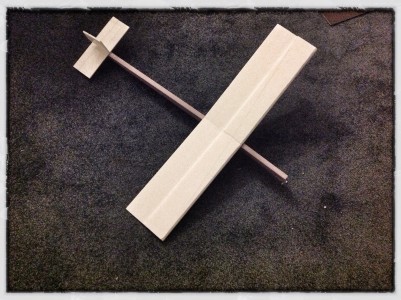I haven’t done much flying this week, in part because we’ve begun to get some rain here in the SF Bay Area, but also because I have just been having difficulty controlling the Nutball. I began to think that what I needed was a proper trainer airplane. A couple of weeks ago, I read this interesting post by seanfoster on the flitetest website, detailing some basic design dimensions that you could use to generate a docile trainer. I decided to try to use this proportions and mate them to the KFm-2 wing that I made a couple of days ago, to see what the overall proportions would look like. I decided to use some of my pink 1/2″ foam for the body, and made a tail out of Dollar Tree foam board. The idea here was not to generate a flying model, but really just to put together the pieces in the proper proportion to see what it looked like, and judge the overall balance and sturdiness of the construction, and just whether I liked the overall size and shape.
Here’s a couple of pictures of the resulting airplane, just hot glued together and photographed in my living room.
The overall body length is 30″, which is five times the six inch chord of the wing, which has a 30″ wingspan. The body has a maximum height of 3″ (10% of the it’s length) and the nose section tapers down to 2″ symmetrically, while the back section starts tapering back to just 1.5″, starting at 12″ from the front of the nose. The tail is 9″x3″, with a 3″x3″ vertical stabilizer, and 1″ elevators and rudder sections. The resulting aircraft is quite tail heavy, but of course lacks the motor that a real RC airplane would have. I don’t have any spars in place, so the body itself was pretty floppy. I’m not displeased with the overall shape, although I wonder about the tail: it seems a bit small to me. I also did not give much thought to the ailerons or elevators. I was thinking of having just elevator/rudder control, and wonder if their relatively small control surfaces would make the plane difficult to control. The guidelines provided are for four-channel control, I was wondering if a three channel rudder/elevator would be easier to do, and would therefore also require additional tail changes. I’m trying to come up with something docile and easy to fly, rather than acrobatic, so perhaps less is more.
I might try weighting the nose of this prototype a bit to get it to balance, and then see if it works in a glide test. If I do, I’ll be sure to shoot some video and let you know how it works out. Stay tuned.
Addendum: Sigh. Apparently, I can’t do math. The recommendation is that the tail have between 20 and 30 percent of the area of the main wing. My wing has an area of 180 square inches, whereas my tail has an area of just 27 square inches (about 15%). A better tail would be 12″ by 4″, with a 4″x4″ vertical tail, which would have an area of about 48″, which would be about 27% of the main wing area. Luckily, a little isopropyl alcohol on the tail section will dissolve the hot glue, and I can try replacing it. I should have double checked my math before starting.

